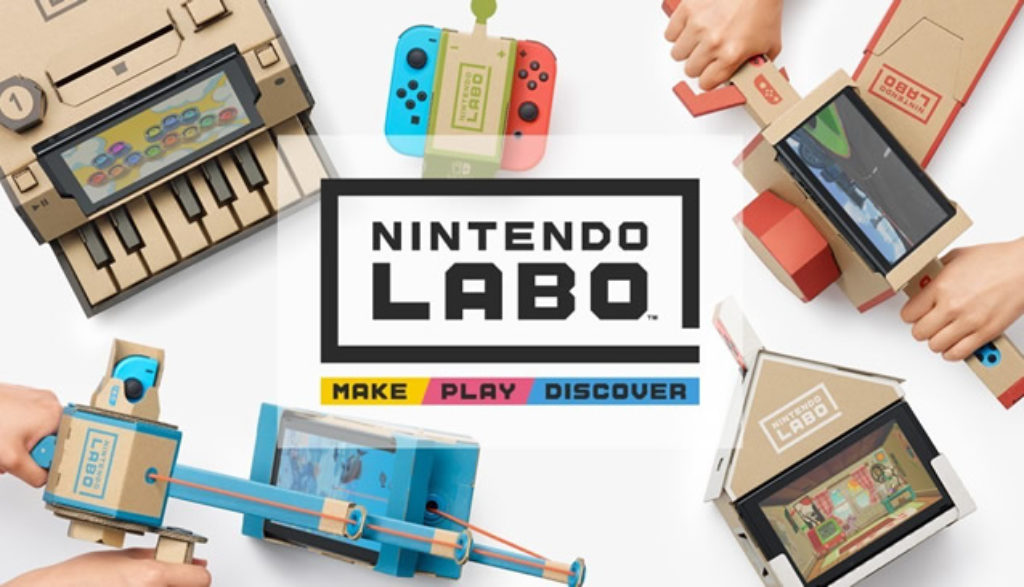
Ah, the joys of cardboard.
It might seem as if the creative fun of making a rocket ship or a fort out of a tossed-aside cardboard box is a kiddish thing of the past in this technologically connected day. I mean, why would a tyke want to focus on such imaginary cardboard-and-crayon pursuits when he or she can flip on the Xbox and see outer space it in all its digital glory?
The creative minds at Nintendo, however, still believe. They still think a hunk of cardboard—especially when used in combination with a little video game support—can be magical. And their Nintendo Labo kits are designed to prove that notion.
The Nintendo Labo Toy-Con Variety Kit that I played around with is actually a package of five different building projects, all of which begin as a box full of perforated cardboard sheets and a tiny Switch console game cartridge for tech support.
After slipping the cartridge into the console and following the onscreen tutorial through a bend-this-flap-here-and-slip-that-tab-there introductory process, three things quickly became clear: The cardboard models are well-thought-through pasteboard marvels. The little Switch console Joy-Cons have functions I never dreamed they had. And Nintendo must be run by a bunch of creative smarties who definitely deserve a pat on the back.
So, what can you expect?
First of all, this kit includes: a rudimentary, steerable RC car that judders around on its cardboard legs; a little house that showcases the Switch’s portable touchscreen and has slots for game-applicable cranks and buttons; a motorbike handlebar construct; an expanding fishing rod; and a small cardboard piano with individual keys that each ring out when you push them down.
These inventive cardboard frameworks initially require, oh, about 20 minutes to two hours to construct. But, of course, that’s what makes it all so fun. When parents and kids get into the mix together, it becomes a joyful, cooperation-building endeavor. And the software support is very easy to use. The LEGO-like building instructions allow you to turn and swipe the image on the Switch touch screen to see clearly where each cardboard bit fits.
Then, completed models all have some kind of arcade-style game support. For instance, the RC cars (there are actually two cars in the kit) have slots where you can neatly nestle the Switch system’s detachable Joy-Con controllers. With a few touches to the console touch screen, the vibrating Joy-Cons make the car move right, left or straight. In other models, such as the motorbike handlebars or the fishing pole, the inserted Joy-Cons use their built-in motion sensing mechanisms to send info to the screen during gameplay.
For instance, the expanding fishing rod has a reel that clicks when you turn it. And as the rod is tipped and tilted while trying to snag onscreen fish, the virtual fishing line matches your movements perfectly. And that intricately built piano? The Joy-Con’s IR camera picks up on bits of reflective tape that you apply to the piano’s inner workings. It then communicates each key’s unique tone to the game screen. Oh, and a studio mode lets you create simple compositions and add things such as a drum track.
All of that to say that it’s not just the model-building that keeps you busy. There are lots of games to play around with when the building is done.
And for those tykes (or parents) who are feeling really creative, there’s even a Toy-Con Garage mode that enables you dig down under the surface of the programming and set up fun new connections between your models and your games. You can, for instance, program your motorbike handlebar model or, say, your piano’s keys to control your RC car’s movements, if you have the right number of Joy-Cons.
For those kids who aren’t quite that adventuresome, though, just decorating your glorious inventions with the right Crayola colors and some brightly colored pipe cleaners adds another layer of old-school fun here.
Now, I can already hear some of you parents out there saying: Wait a minute! This is just flimsy cardboard right? I know how rough my kid’s play can get. And, of course, you’re right. Cardboard is just cardboard. But the folded structures end up being pretty well supported.
And there’s another thing that came to my mind as I pieced the models together. After you punch out the model forms, you shouldn’t throw the initial pre-punched sheet away. That sheet can be reused as a templet to make replacement parts if you mix some spare cardboard, a pencil and a mom who’s handy with a utility knife.
Let me close by saying that, as gung-ho as I may sound about this build-and-play kit, I know that some kids aren’t gonna be into it. It really does require tykes who love this sort of work-with-your-hands play. (And preferably a parent who can join in for an hour of cardboard folding, too.) But for the right creative kid and a parent willing to pop for a pricey package of corrugated paper product, hey, cardboard nirvana awaits.

After spending more than two decades touring, directing, writing and producing for Christian theater and radio (most recently for Adventures in Odyssey, which he still contributes to), Bob joined the Plugged In staff to help us focus more heavily on video games. He is also one of our primary movie reviewers.